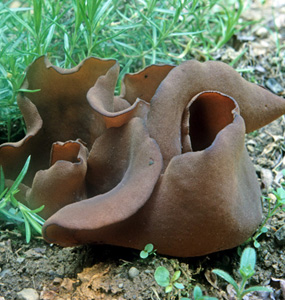Peziza badia

Image Courtesy of Peter Katsaros
| Click to Enlarge |
| Click For Image Gallery |
|
Group of Fungi: Cup Fungi Family: Pezizaceae Latin Name: Peziza badia Pers. Common Name: Common Brown Cup Description: Shallow cup-shaped structure, 1 1/4–3 in (3–7.5 cm) wide, margin often wavy; upper fertile surface reddish brown, smooth; lower sterile surface dark brown to purplish brown, somewhat scurfy; stalk lacking; spores hyaline in mass. Biological Role: Decomposer of litter, humus and well-decayed wood debris. Habitat: On the ground or associated with well-decayed wood debris in broadleaf or conifer forests; occurring as solitary fruiting bodies or in small groups. Geographical Distribution: Widely distributed throughout North America. Comments: Peziza badia and the very similar Peziza badioconfusa are essentially identical in appearance but can be distinguished on the basis of microscopic features (the spores are slightly different) and the time of the year when they are most likely to be encountered. Fruiting bodies of Peziza badioconfusa tend to be found in the spring and early summer, whereas those of Peziza badia generally occur during the late summer and fall. Both species are considered edible, but they are rarely collected for human consumption because of their small size. |
| Go Back |